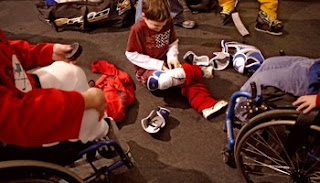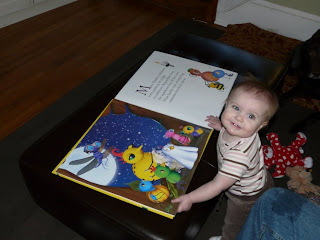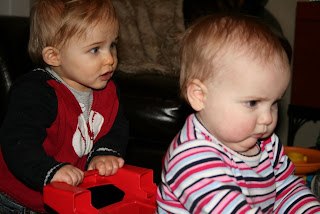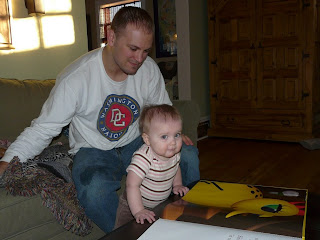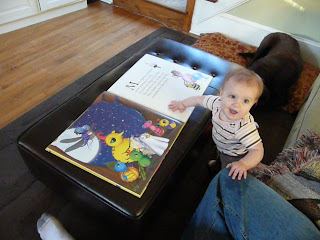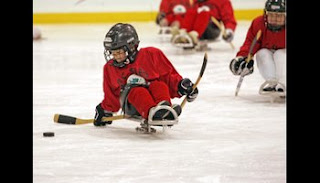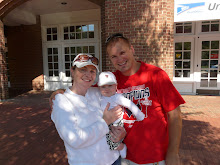Photos by (Katie Falkenberg/The Washington Times)
They love to go fast and bang into the boards just like any ice-hockey player.
Their favorite player? The Capitals' Alex Ovechkin, the No. 1 goal-scorer in the NHL. Duh.
But unlike other hockey players their age — 4 to 15 years old — they don't actually strap skates on their feet or use a stick. In fact, they use two, one for each hand.
That's right. This is not just any ordinary team. This is the D.C. Sled Sharks, a sled-hockey team in Arlington for children with lower-limb paralysis.
Most of them were born with spinal bifida, a congenital condition that results in an incompletely formed spinal cord. This, in turn, often results in decreased mobility in the lower limbs.
Photo Gallery: Sled hockey
click image to view gallery
They love to go fast and bang into the boards just like any ice-hockey player. Their favorite player? The Capitals' Alex Ovechkin, the No. 1 goal-scorer in the NHL. Duh. But unlike other hockey players their age 4 to 15 years old they don't actually strap skates on their feet or use a stick. In fact, they use two, one for each hand. That's right. This is not just any ordinary team. This is the D.C. Sled Sharks, a sled-hockey team in Arlington for children with lower-limb paralysis.
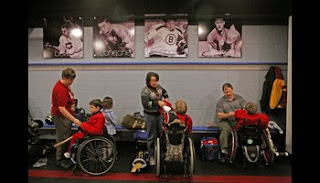
Like Sean Thomason, 7, who can't walk without braces. At home, he just crawls and when he plays basketball, he uses a wheelchair. When he plays hockey, he sits in a, well, sled.
"He does a lot of sports, but this is by far his favorite," says his mom, Amy Thomason, while watching her son on the ice from the bleachers at the Kettler Capitals Iceplex in Arlington on a recent Sunday.
"In his mind, he's playing sled hockey for the Capitals when he grows up."
Louie Schaab, 13, also doesn't lack ambition. He wants to be an NHL coach.
"Or a green biologist," says Louie after the one-hour-plus practice. His hair is wet from sweat and effort. He's waiting to be lifted to his wheelchair from his sled, which has a low backrest. Other sleds have taller backrests. Or, as in the case of Nick White, 6, includes a handle in the back that his dad, Lee White, can push while skating behind his son. Nick has Lesch-Nyhan syndrome, caused by a congenital enzyme deficiency. Among the physical effects of the disorder is a lack of mobility.
"The sleds are basically all made to fit the kids," says Joan Joyce, a recreation therapist at the National Rehabilitation Hospital, which helps organize, sponsor and raise funds for the team. Rink time, which normally runs about $450 an hour, is donated by the Capitals. The total cost for participating in the D.C. Sled Sharks to parents so far: $0.
"The parents have enough expenses already. We don't want this to be an extra burden," Ms. Joyce says.
Sled hockey, which was started in Sweden in the early 1960s, became an official Paralympic sport at the 1994 Winter Games in Norway. The sled has a bucket seat and two hockey blades mounted on the frame.
The dual sticks are about 3 feet long and have two metal picks at one end. These are used to help propel the player forward on the ice. The other end of the stick is for hitting the puck.
That's where tailoring to the disability ends.
They use regulation-size nets, pucks and rinks, and coach Brian Dutton believes in tough love and teaching independence as much as possible.
"I don't want to coddle them," he says. "I want them to figure it out on their own as much as possible."

This means giving the children time to try to get up on their own when their sleds tip over. This take a takes a lot of arm and core strength, and patience.
"It's about life skills as much as it's about hockey," says Mr. Dutton, who is not disabled but is an avid hockey player himself with the Goons, a masters league team in Fairfax. Sean's mom couldn't agree more.
"Sometimes, you just have to let them sink or swim," Ms. Thomason says. "We're preparing them for a life of independence."
Sean seems to be adopting that motto already. He's already informed his mother that when she ages, he'll be too busy to stick around and help her.
He says: "I'm going to be busy traveling the world. I won't be able to take care of you."
Well, that might be the appeal for the parents. But for the kids it's about hockey and only about hockey: feeling the cold air on your face, the smoothness of the newly cut ice and scoring goals, goals, goals.
Which Vitaly Ricci, 15, knows all about. He was the team's No. 1 scorer and the player of the month, for which Mr. Dutton awarded him a Capitals practice puck.
"What's not to like?" Vitaly says. "You can go really fast, and you can bang into the boards."
He also likes lifting weights and playing tennis and basketball, which he does using a wheelchair.
His mom, Sandy Ricci, calls him a superb athlete and says, "He's hell on wheels in basketball."
He does this despite having arthrogryposis multiplex congenita, a congenital condition that results in crooked joints and leads to decreased mobility in all limbs. His arms and hands bow inward — as do his legs and feet — as if he had severe arthritis.
On Monday, he will have back surgery to correct scoliosis, but only after he's played a game in Philadelphia on Sunday. He's an athlete with big dreams.
"He's learning Finnish right now," says Ms. Ricci. "Because his dream is to play hockey with a Finnish team when he grows up."
Head coach Brian Dutton teaches independence to the D.C. Sled Sharks, a hockey club for children with lower-limb paralysis. "I don't want to coddle them," he says. "I want them to figure it out on their own as much as possible." (Katie Falkenberg/The Washington Times)
Sled-hockey player Mark Hoppmann, 13, looks at hockey sleds after practice with Joan Joyce, a recreation therapist at the National Rehabilitation Hospital, which helps organize, sponsor and raise funds for the team. “The parents have enough expenses already. We don't want this to be an extra burden,” she says. (Katie Falkenberg/The Washington Times)
Sean takes off his hockey padding after practice. The sled-hockey team uses the same rink as the Washington Capitals; the team donates rink-time costs, which run about $450 an hour. (Katie Falkenberg/The Washington Times)
Parents of children on the D.C. Sled Sharks team help out with gear before a recent practice. Beyond some tailoring of equipment, including dual sticks and bucket seats, the players use regulation-size hockey nets, pucks and rinks. (Katie Falkenberg/The Washington Times)
Sean Thomason, 7, a member of the D.C. Sled Sharks, goes in for a shot last month during practice at the Kettler Capital Iceplex in Arlington. He also plays basketball, in a wheelchair, but hockey is his favorite sport.
